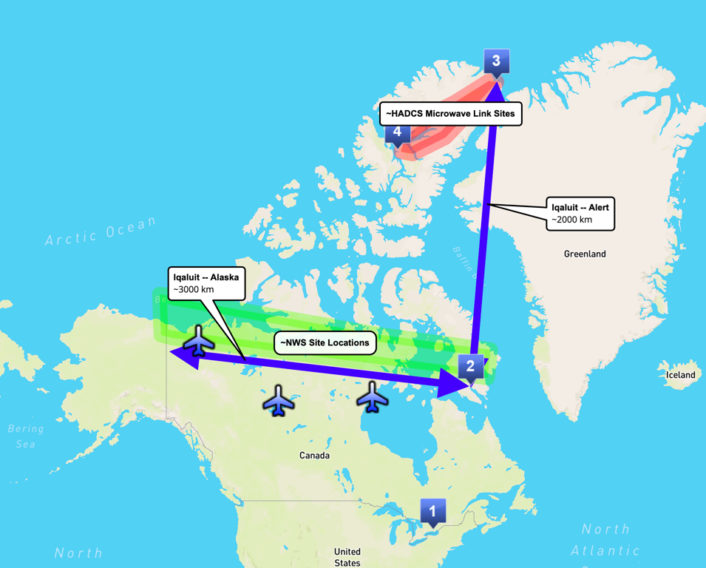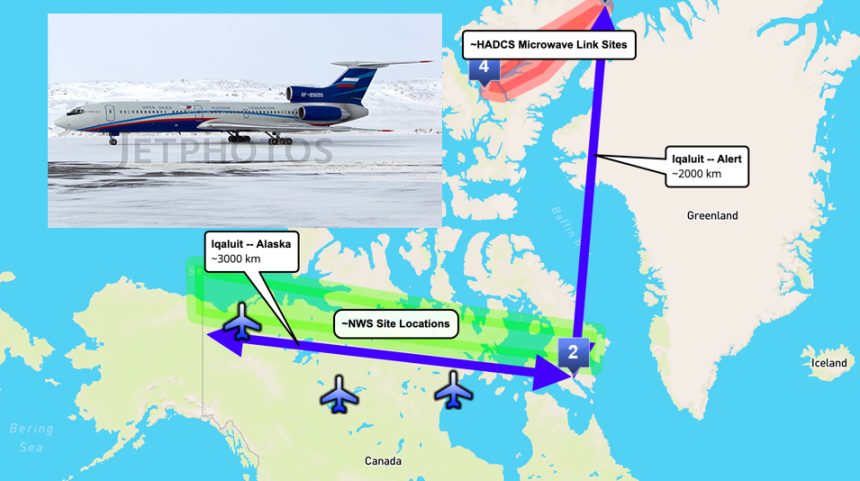Analog vs Digital: Canada under observation by Russian Open Skies Treaty mission, while multinational mission is over Russia.
According to Canadian Department of National Defence officials, Russian officials, and open sources, from Jul. 22 to Jul. 27, an inspection team from the Russian Federation will be conducting an Open Skies Treaty overflight of Canada, in accordance with the provisions laid out in the Treaty on Open Skies.
Members of the Department of National Defence Strategic Joint Staff Arms Control Verification (SJS ACV) team will be aboard the Russian Federation treaty-certified Tupolev Tu-154M LK-1, to monitor the observation flight, and ensure compliance with all aspects of the treaty and flight safety while in Canadian airspace. The digital electro-optical sensor the Russian Air Force (RuAF) will be using has the same capabilities as the other sensors installed in their other Open Skies Treaty certified planes, including their Antonov An-30B, and their most recently certified plane, their Tupolev Tu-214ON. The digital electro-optical sensor conforms to all limits outlined in the treaty, capturing imagery visible and NIR spectrum, at a maximum resolution of 30cm.

The Treaty on Open Skies currently has 34 signatories, but was originally signed in 1992, and only came into force in 2002. Each country must conform to the terms outlined in the treaty, but there are additional procedures still left up to each country to implement how they see fit. Contacted for additional information about the flight, Canadian Department of National Defence officials declined to provide additional flight path information, and do not plan to issue a Notice to Airmen (NOTAM), which would show where the Russian Federation will be flying and taking pictures. This is different from British and Italian officials who regularly publish a NOTAM when Russian flights are conducting overflights of the United Kingdom and Italy respectively, as a warning to other flights in their path. These published flight plans have the additional benefit of allowing plane-spotters and open source researchers to follow Russian yearly visits. In contrast to the UK and Italy’s transparency, American officials do not publish any flight information either, suggesting the Canadian Department of National Defence is following their lead.
Perhaps counter-intuitively, the Russian Ministry of Defence is more forthcoming with information about their treaty-approved observation missions, as well as other countries’ overflights of Russia.
Early on the morning of Jul. 22, the official Russian Ministry of Defence newspaper Krasnaya Zvezda (literally “Red Star”, in Russian) publicly announced their observation mission over Canada, that it would be flown from Iqaluit, and fly a distance of less than 6150 km, as limited by the treaty. No such announcement was made from the Canadian Department of National Defence, despite being notified of the upcoming flight the previous week.
Beyond photographing the landscapes of Canada’s North, there are a limited number of publicly known sites of military interest in the arctic to photograph from the air. These sites include, but are not limited to:
- The North Warning System (NWS): a line of radar sites that cross Canada’s North as well as Alaska; the evolution of the original Cold War Distant Early Warning system.
- The High Arctic Data Communication Systems (HADCS): a series of terrestrial microwave sites which provide SATCOM access to satellites not visible from CFS Alert, allowing a data link to CFS Leitrim.
- CFS Alert is over 2000 km from Iqaluit as the crow flies, but it may be possible, weather permitting, for the Russians to photograph CFS Alert on this mission.
- The Nanisivik Naval Facility is Canada’s northernmost naval facility was scheduled to be operational this summer, it could be a target of their observation flight.
- SuperDARN research sites, which may be working with Raytheon to conduct over the horizon missile defence research could be of interest.
- Royal Canadian Air Force / NORAD Forward Operating Locations in Rankin Inlet, Iqaluit, Yellowknife, and Inuvik; recent visits and statements by NORAD officials suggest they are being upgraded to meet new demands, also potentially of current interest.
- Several remote testing, and research sites, are also located in the Canadian arctic, and could be of interest.
The Russian team arrived in Trenton on Monday July 22 after a 12 hour flight from Kubinka, Russia, including a stop in Reykjavík, Iceland, for fuel. CFB Trenton may seem far from Iqaluit, and it is, but it is also the closest treaty-allowed entry point for Open Skies Treaty observation flights. Once the flight plan has been negotiated between Russian and Canadian officials in Trenton, the plane will be rigorously examined by the RCAF to ensure compliance with the Open Skies Treaty, and only then will the Russian observation team, with their Canadian observers, fly to Iqaluit to perform the observation flight on Thursday and/or Friday.

While the Russians overfly Canada, coincidentally, the Canadian Arms Control Verification Team will overfly Russia. Canada is co-leading an Open Skies Treaty mission with the United States and Hungary, using the Hungarian Antonov An-26 certified observation plane, and wet film cameras. The joint observation mission will be accompanied by representatives of the Russian Federation, and just as the Russian plane was inspected in Trenton, the Hungarian plane will be inspected at the Kubinka Airfield to ensure all elements of the treaty are being respected aboard the Hungarian aircraft, before the mission takes place.
Canada’s participation in the Russian flight is not just lip-service: “The Canadian Armed Forces (are) providing operations and sensor specialists from its Open Skies section. A total of three 3 Canadian personnel are participating in the planning and the execution phases of the aerial observation mission” said Canadian officials. “The Treaty on Open Skies is one example of how Canada exercises its commitment to reducing the threat of armed conflict by increasing trust and confidence through developing greater openness and transparency between states.”
This is not the first time the Canadian Forces have provided personnel for joint flights with other signatories of the Open Skies Treaty, it’s a common practice. During the week of Dec. 3 to 7, 2018, the United States performed an Open Skies Treaty flight over Ukraine, exercising Annex L Section III; “Extraordinary Flights”, from the Treaty on Open Skies. Without leveraging that section of the treaty, no flight would have been possible, because the 2018 quotas were unable to be ratified at the Fall 2017 plenary in Geneva, resulting in an absence of any quota-based overflights in 2018.
That December overflight of Ukraine was performed by a multi-national team of observers aboard the American Open Skies Treaty-certified OC-135B, included a team from the Royal Canadian Air Force. Reached for comment, Canadian Department of National Defence officials stated they were “tasked to co-lead this observation mission and provide operations and sensor specialists from (their) Open Skies section.” Flight data shows that earlier in 2018, the American OC-135 had been conducting a mission over Canada as well, but DND officials clarified that the mission they were flying was only a training mission between the 19th and 23rd of February 2018; “The aim of this exercise is to provide training for Canada’s government departments and agencies that are involved in the conduct of OPEN SKIES flights over Canada.” furthermore, “In order to retain the notion of realism of an actual quota overflight, the participants from the United States take up the role of the ‘Observing Party’, using the respective real-life (Open Skies Treaty) callsigns.”
Based on the 2019 flight quota allocated to the Russian Federation, this week’s flight over Canada will be the only flight Russia conducts over Canada in 2019. If you missed your plane-spotting opportunity in Reykjavík, Trenton, or Iqaluit, don’t worry, they’ll be back again in 2020.
Steffan Watkins is a open source research consultant specializing in ship and plane movements, who writes about his personal research involving ships and planes on his blog Vessel of Interest.









